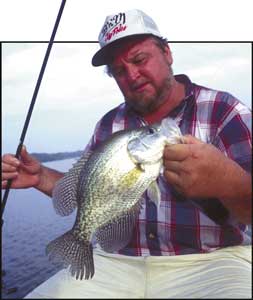
Phillips uses fluorocarbon line because it disappears and has the sensitivity of braid
EDITOR’S NOTE: This is the fourth article in an online series on hot crappie spots across the state that originally appeared in Louisiana Sportsman magazine. Today’s article features information on Caney Lake, and tomorrow we focus on Bayou Black.
Five of Louisiana’s Top 10 record black crappie came from Caney Lake, and Bobby Phillips said conditions are improving again now that the grass carp have been removed from the 5,000-acre reservoir.
“It’s come on strong. It’s getting a little grass back in it now, and the bass, white perch and yellow bass have all come on strong, along with the chinquapin,” he said. “It’s got some good crappie in it, too.”
Located southwest of Monroe and east of Jonesboro, the same rules apply at Caney Lake as at Lake D’Arbonne: north Louisiana’s winter in February will determine when the crappie spawn begins.
“They don’t all spawn at the same time, so you have a chance to catch them shallow or deep in either one of those lakes,” Phillips said.
For deep water fish, Phillips suggested fishing out from the dam and vertical jigging using a Bobby Garland baby shad in blue thunder with a chartreuse tail or double silver rainbow.
He suggested using a fish finder to target the crappie in deep water.
“Normally they’re suspended a little higher than what the yellow bass are,” Phillips said. “Sometimes you catch crappie suspended at 25- to 28-feet in 30- to 35-feet of water.
“Try to figure out where they’re at and fish a foot above them to start out. If that doesn’t work, go below them. You have to keep bouncing around until you get the magic depth, then just lock your reels and try to get to the same depth every time.”
Phillips uses 6-pound fluorocarbon for shallow-water fishing, and 8-pound fluorocarbon in deeper water in the channels.
“The reason I use fluorocarbon is it disappears in the water, the fish can’t see it and it has the sensitivity of braided line,” he said. “When a fish hits it, you can really feel that bump.”
If the spawn does start in February, he suggested trying the Smith Branch for shallow-water action.
“You can catch them down there on ultralights, or corks, retrieving a beetle spin, shiners or just about any kind of way,” he said.
As daylight hours increase with the approach of spring, Phillips said water temperatures need to reach about 60 degrees to kick-in the spawn.
“I shoot for around 58 to 65 degrees consistently. It has to stay that way overnight, too,” he said. “When it’s cold, they just won’t spawn.”


